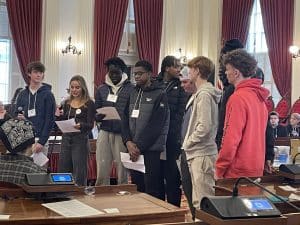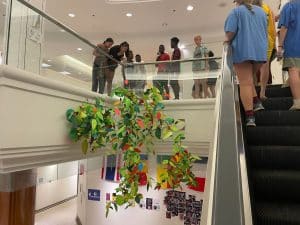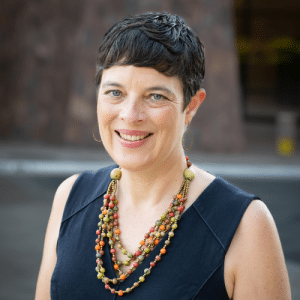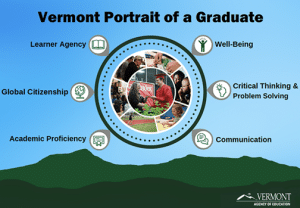Celebrating 10 Years of Flexible Pathways Legislation in Vermont
CompetencyWorks Blog
As I arrived in Montpelier and got out of my car to head up the hill on a chilly 19-degree day, a yellow school bus pulled up and a group of students with their educators filed out. We were all heading to the “sold out” Act 77 Anniversary Celebration and Convening at the State House, hosted by the Vermont Agency of Education (VT AOE), UP for Learning, the Vermont Principals Association, the McClure Foundation, and the Vermont Virtual Learning Cooperative. A day of celebration and reflection on what teaching and learning does and can look like in Vermont school systems that embrace student-centered practices lay ahead.

The Story of Act 77
The 2013 legislation Act 77, the Flexible Pathways Initiative, paved the way for programs around flexible and alternate pathways toward graduation, including proficiency-based learning and proficiency-based graduation requirements. Published in conjunction with the Act 77 law, Vermont’s Education Quality Standards (EQS) outline the details of flexible pathways, personalized-learning plans (PLPs), and proficiency-based graduation. In the spirit of Vermont’s local-control system, high schools have wide latitude in developing their own structures and systems to meet the goals of Act 77.
What’s especially important about Vermont’s approach is that it sets a vision for shifting the education system as a whole to a student-centered, proficiency-based approach. Piloting competency-based education models is a common and helpful entry point for states to test out what can be done with greater flexibility. The process of identifying policy barriers through the pilot process can set the agenda for future policy change, but a pitfall in piloting can be that the gap between participating and non-participating schools grows. With Act 77 and the EQS, Vermont committed to a comprehensive change across the system.
The VT AOE regularly engages the education community in developing and testing resources. Elements of the competency-based system and example supports include the following:
- VT Proficiency Based Graduation Requirements (PBGRs) support creating a competency-based system that allows progress based on evidence of proficiency. Learners are able to excel by fully demonstrating what they know and can do.
- Personalization/Student-Centered Learning brings flexible pathways to life in developing learning experiences within and beyond school and supporting students with personalized learning plans.
- Tiered Systems of Support meet students where they are to help all students attain the knowledge and skills they need.
- Local Comprehensive Systems of Assessments help ensure equitable opportunities for all students to gather evidence of proficiency in relation to PBGRs. In particular, performance assessments engage students in meaningful learning in authentic contexts, require a genuine application of knowledge, and yield a tangible product and/or performance that serves as evidence of learning. The issue brief, Strengthening Local Assessment Systems for Personalized, Proficiency-Based Education: Strategies and Tools for Professional Learning, by Pat Fitzsimmons at the VT AOE, offers additional tools.

Act 77 in Action Through the Eyes of Students
The program highlighted bright spots of schools and programs working to implement Act 77. Each featured students telling their stories of how flexible, student-centered learning opportunities had opened new pathways and sparked new possibilities for their futures. These snippets provide a glimpse of the range of approaches to creating flexible pathways. More examples and details are available in the event slides.
Flexibility Through Personalized Projects and Learning
Twinfield’s Renaissance Program allows students to pursue personalized learning projects in areas of interest. Students choose proficiencies to meet in their project, including transferable skills, and are assessed by a panel. The program started in 1999 and has flourished under Act 77. The presenting educator shared that projects help students struggling to find their way in the curriculum get grounded through exploring their interests and allow students who already know their passion to go deeper. Three students shared a range of projects where they learned from mentors and applied their learning in real-world settings on topics including American Sign Language, coding, small engine design, Victorian feminist literature, drums, running, Arabic, and activism.
Learning Beyond the School Setting
Several of the bright spots featured new learning environments beyond the school walls, whether as a complement or extension to school-based learning or as an alternative for a semester or longer. Burlington City & Lake Semester offers students at Burlington High School English, social studies, and elective credit while working together on projects that address real-world issues in the community. Participants shape each semester’s project on a topic connected to “Burlington’s culture, people, and natural environment; city systems; local issues; and the things that make a community thrive.” The students presenting worked on a project on the question: What does art do for us? In collaboration with artist Rebecca Schwarz, they explored themes of the environment and activism and created a leaf mobile for the high school.

Habitat for Aviation is a Big Picture Learning B-Unbound apprenticeship program for female students interested in aviation. Students can get credit for their work – mainly done on weekends, though sometimes during school hours – in a group collaboration to build a plane, learn about aviation mechanics, and even work towards their pilot license.

Industry Partnerships
Flexible pathways align with career and technical education and work-based learning. New programs are also bringing industry experts into innovative learning environments like Generator MakerSpaces. Generator-BETALab is one such collaboration between BETA Technologies and Generator that provides realistic design challenges with industry professionals. Initially piloted in one of the original Generator MakerSpace sites last year, they are expanding to new sites. Students shared how the experience of learning about electromagnets in the context of electric flight brought the science to life in new ways.
Redesigning School Systems for Proficiency-Based Learning
Bellows Free Academy, Fairfax focused their journey on redesigning their core structures, including discipline-specific and transferable skills proficiencies that guide course and graduation requirements and are used by students and teachers in day-to-day learning as well as reported on in official transcripts. The learning culture focuses on who students are as learners and ensuring students are proficient. To shift away from grade point averages, they offer “Graduation with Distinction” as a way that students can pursue deeper learning in areas such as STEM, the arts, and humanities.
Lessons From Vermont’s Comprehensive Approach
If we want to realize our vision of equitable learning opportunities that allow young people to graduate with the knowledge, skills, and dispositions they need to thrive in a changing world, we must realize that systems cannot be one size fits all for schools and districts. Vermont shows one approach to creating flexibility for students and for systems change. The work is challenging and takes time, but 10 years into Act 77 Vermont educators, students, and communities have created many examples of what is possible.
 I don’t believe that anyone in the State House chamber would have said there isn’t more to do – either in refining and evolving the wonderful models shared in all of the bright spots or in making those opportunities available to every student who is interested. As we move forward, Vermont offers insight into how the work of scaling and expanding learner-centered models could unfold across the U.S. Underlying the change process, we find a shift in mindset to accept that there is not one right way or one right answer for every challenge. Learner-centered, competency-based education will not look the same in every school in every community.
I don’t believe that anyone in the State House chamber would have said there isn’t more to do – either in refining and evolving the wonderful models shared in all of the bright spots or in making those opportunities available to every student who is interested. As we move forward, Vermont offers insight into how the work of scaling and expanding learner-centered models could unfold across the U.S. Underlying the change process, we find a shift in mindset to accept that there is not one right way or one right answer for every challenge. Learner-centered, competency-based education will not look the same in every school in every community.
It is time to more seriously and effectively invest energy and resources into implementation efforts that apply what we’ve learned from educational research and the science of learning. We can offer greater autonomy and flexibility for those ready to design high-quality systems while also providing model systems and structured support with more incremental pathways for those who need it. Some systems, especially large systems and places closer to the start of this journey, will need more guidance and support. We can monitor equity and design accountability systems with flexibility for systems with different levels of readiness.
Learn More
- A Cornucopia of Competency-Based Education Resources from Vermont
- Essential Components of Local Assessment Systems for Personalized, Proficiency-Based Learning
- Personalized Learning Plans at Bellows Free Academy in Fairfax, Vermont
- Vermont’s Comprehensive, Statewide Approach to Personalized Learning
 Laurie Gagnon is the CompetencyWorks Program Director at the Aurora Institute. She leads the work of sharing promising practices shaping the future of K-12 personalized, competency-based education (CBE). She had the opportunity to spend the morning at Bellows Free Academy, Fairfax the day after the Act 77 Celebration event and looks forward to sharing more stories from Vermont.
Laurie Gagnon is the CompetencyWorks Program Director at the Aurora Institute. She leads the work of sharing promising practices shaping the future of K-12 personalized, competency-based education (CBE). She had the opportunity to spend the morning at Bellows Free Academy, Fairfax the day after the Act 77 Celebration event and looks forward to sharing more stories from Vermont.
